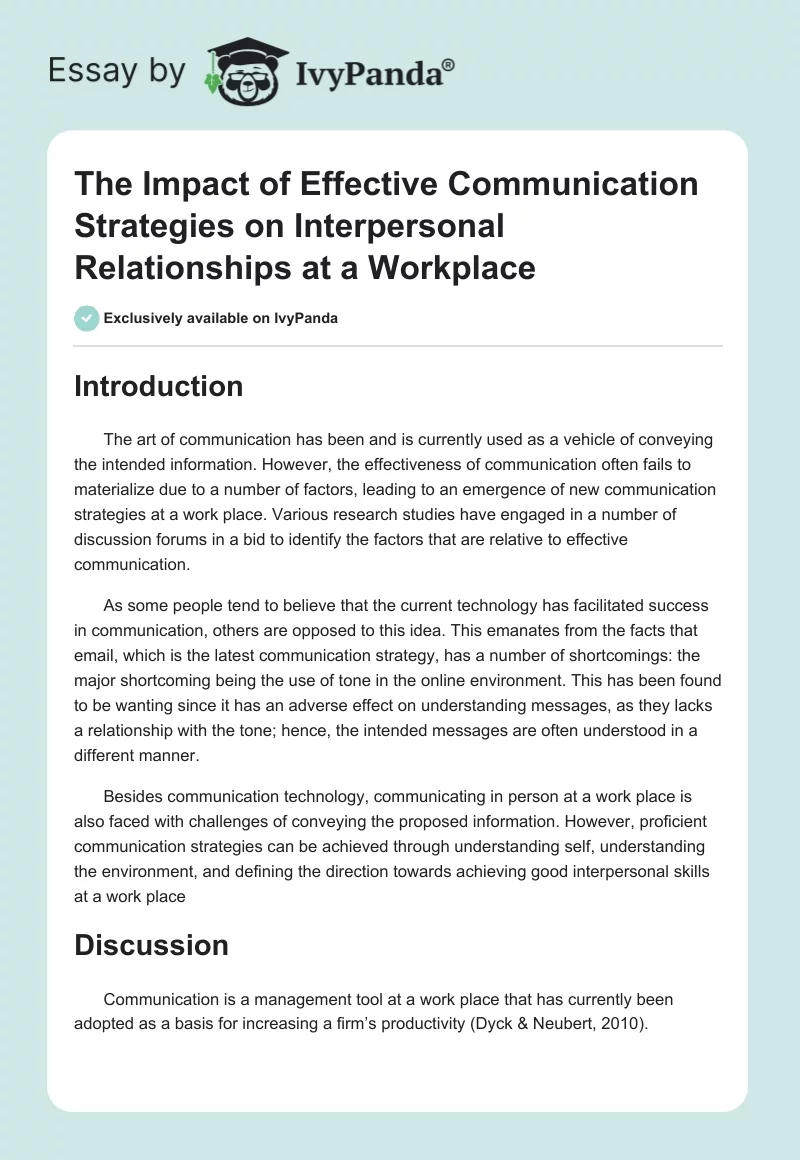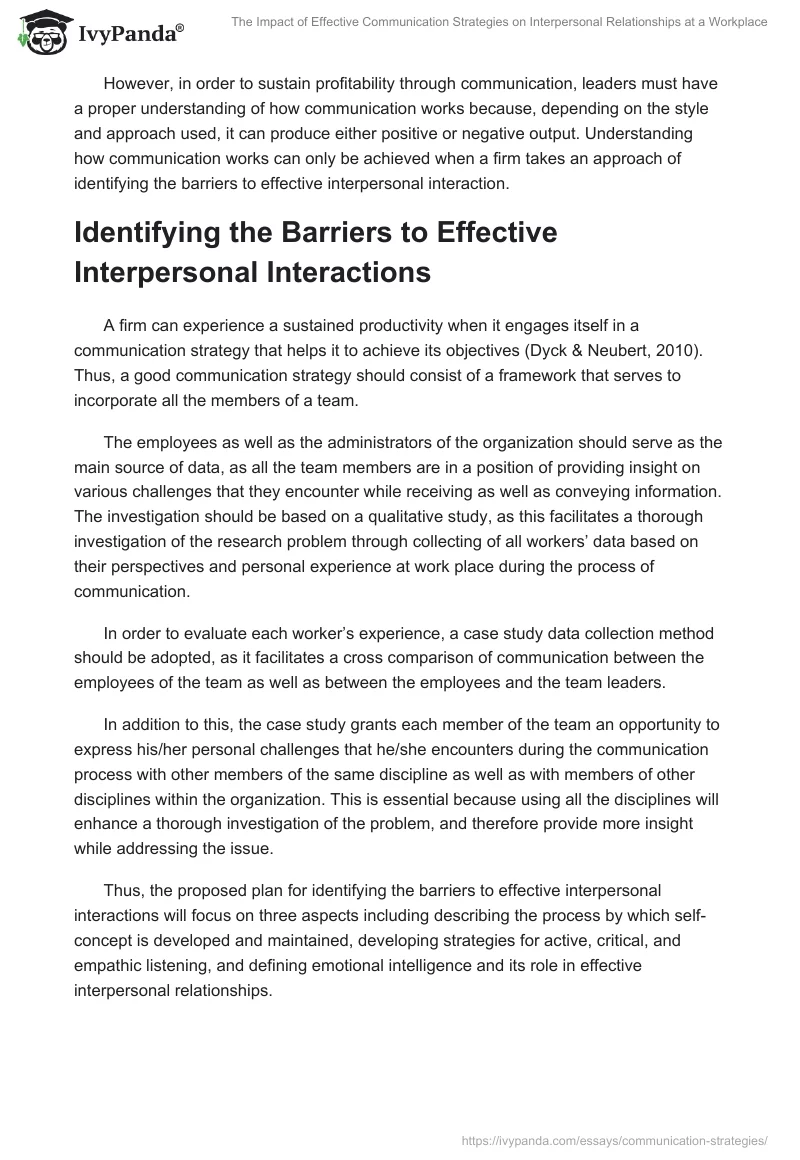- Introduction
- Discussion
- Identifying the Barriers to Effective Interpersonal Interactions
- Process by Which Self-Concept Is Developed and Maintained
- Developing Strategies for Active, Critical, and Empathic Listening
- Emotional Intelligence and Its Role in Effective Interpersonal Relationships
- Conclusion
- References
Introduction
The art of communication has been and is currently used as a vehicle of conveying the intended information. However, the effectiveness of communication often fails to materialize due to a number of factors, leading to an emergence of new communication strategies at a work place. Various research studies have engaged in a number of discussion forums in a bid to identify the factors that are relative to effective communication.
As some people tend to believe that the current technology has facilitated success in communication, others are opposed to this idea. This emanates from the facts that email, which is the latest communication strategy, has a number of shortcomings: the major shortcoming being the use of tone in the online environment. This has been found to be wanting since it has an adverse effect on understanding messages, as they lacks a relationship with the tone; hence, the intended messages are often understood in a different manner.
Besides communication technology, communicating in person at a work place is also faced with challenges of conveying the proposed information. However, proficient communication strategies can be achieved through understanding self, understanding the environment, and defining the direction towards achieving good interpersonal skills at a work place
Discussion
Communication is a management tool at a work place that has currently been adopted as a basis for increasing a firm’s productivity (Dyck & Neubert, 2010).
However, in order to sustain profitability through communication, leaders must have a proper understanding of how communication works because, depending on the style and approach used, it can produce either positive or negative output. Understanding how communication works can only be achieved when a firm takes an approach of identifying the barriers to effective interpersonal interaction.
Identifying the Barriers to Effective Interpersonal Interactions
A firm can experience a sustained productivity when it engages itself in a communication strategy that helps it to achieve its objectives (Dyck & Neubert, 2010). Thus, a good communication strategy should consist of a framework that serves to incorporate all the members of a team.
The employees as well as the administrators of the organization should serve as the main source of data, as all the team members are in a position of providing insight on various challenges that they encounter while receiving as well as conveying information. The investigation should be based on a qualitative study, as this facilitates a thorough investigation of the research problem through collecting of all workers’ data based on their perspectives and personal experience at work place during the process of communication.
In order to evaluate each worker’s experience, a case study data collection method should be adopted, as it facilitates a cross comparison of communication between the employees of the team as well as between the employees and the team leaders.
In addition to this, the case study grants each member of the team an opportunity to express his/her personal challenges that he/she encounters during the communication process with other members of the same discipline as well as with members of other disciplines within the organization. This is essential because using all the disciplines will enhance a thorough investigation of the problem, and therefore provide more insight while addressing the issue.
Thus, the proposed plan for identifying the barriers to effective interpersonal interactions will focus on three aspects including describing the process by which self-concept is developed and maintained, developing strategies for active, critical, and empathic listening, and defining emotional intelligence and its role in effective interpersonal relationships.
Process by Which Self-Concept Is Developed and Maintained
A research study carried out by Wood (2009) affirms that self-concept at a workplace can be achieved through reflective thinking. A reflective mindset facilitates the capacity of being able to give as well as receive feedback; hence, making the speaker to stand a good position while handling discomfort.
Practically, reflective thinking can be fully achieved by assuming the position of listener, and then assuming the role of the speaker. This stems from the fact that the major conflict between the speaker and the listener relationship involves personal maturity; therefore, assuming the role of the speaker and the role of the listener facilitates identification of barriers to effective interpersonal interaction (Hybels & Weaver, 2007).
This, in turn, helps in building personal maturity, as both the speaker and the listener are able to develop suitable communication skills that enable them to analyze their interpersonal differences. Such a mindset is of paramount importance since it facilitates the development of my vision, mission as well as values that help in the achievement of the organizational goals.
Self-concepts, however, can only be maintained when we take an approach of shared responsibility (Wood, 2009). Shared responsibility takes into account that the members of a team should practice communication in a user-friendly manner.
By assuming the role of a listener, shared responsibility should commence with asking the relevant questions, as it helps me to pay an adequate attention that triggers a continuous evaluation of the message, and hence improve my communication skills. By assuming the role of the speaker, on the other hand, I am able to understand that the relevant questions asked by the listeners play a critical role in organizing my thoughts, and this helps in providing the listeners with clarity on the topic under discussion.
Developing Strategies for Active, Critical, and Empathic Listening
Listening has been used as a vehicle for adopting successful interpersonal relationship. When done effectively, a person gets into a position of acquiring new information on the topic under discussion (Hybels & Weaver, 2007). However, this can only be achieved through active listening, critical listening, and empathetic listening. In active listening, the participants involve both the speaker as well as the listener.
According to Lum (2005), active listening can only result from speakers who engage in speaking subjects that trigger the mind of the listener, making the listener to process the data under discussion. This, in turn, makes the processed information to become easily accessible in due time through the memory.
Developing critical listening helps the listener not only to listen to the speaker but also to make judgment on the speaker’s message through an evaluation process; hence, it is characterized by persuasive listening. More so, critical listening helps the listener not only to agree with the speaker but also to ascertain the reasons why he/she has to agree with the speaker.
Critical listening can be enhanced through various models, one being the Lyman Steil’s S.I.E.R. model. In this model, the letter S stands for sensing, the letter I stands for interpreting, the letter E stands for evaluating, and the word R stands for Responding (Lum, 2005).
In the empathic listening, the listener reflects an understanding of the message by demonstrating emotional and intellectual intelligence, and hence improves his/her listening capabilities (Lum, 2005).
With proficient and considerate listening skills, the speaker responds to the listener using a style that tries to understand accurately the listener’s perspective by trying to understand the discrepancy between his/her actual behavior and the ideal behavior. Thus, empathetic behavior can be developed by illustrating an aspect of acceptance, regardless of whether someone agrees or disagrees with the other person.
Emotional Intelligence and Its Role in Effective Interpersonal Relationships
Emotional intelligence is defined as an intelligent that helps to improve someone’s attitude and habits in order to make the desired change (Goleman, 2006). In his research findings, Goleman (2006) found out that emotional intelligence plays a critical role in identifying the barriers to effective interpersonal interactions.
Thus, I can achieve proficient interpersonal interactions through a number of steps including understanding my emotions, evaluation the ways that facilitate management of my own emotion, identifying ways that motivate me towards the desired change, making a point of being acquainted with other people’s emotions, and coming up with ways that foster management of other people’s emotions.
Goleman (2006) asserts that understanding my emotions plays a critical role in developing a reflective mindset. A reflective mindset has a connotation with conviction, which helps me to standardize my emotions. This, in turn, creates an avenue for changing my interpersonal behavior.
Evaluating the ways that facilitate management of my emotions can be achieved through goal setting. Goal setting plays a role of in enhancing my interpersonal skills, as it takes an approach of defining the ability to solve a problem as well as the ability to manage conflicts (Hybels & Weaver, 2007). More so, goal setting helps me to acquire interpersonal skills, as I am able to attempt particular interpersonal skills, even before getting the knowledge of its conceptual framework.
Identifying ways that motivate me towards the desired change facilitates rewiring of my brain. This identification helps in developing a proficient listening habit since it takes an approach of developing a practice of giving and receiving feedback in a bid to deal with the discomfort that results from the feedback (Goleman, 2006). This approach is of paramount importance since it helps in structuring of vision, mission as well as values.
Making a point of being acquainted with other people’s emotions is of utmost importance in developing interpersonal skills since it entails carrying out an analysis concerning other people’s emotions. This works on the basis that an analytic mindset facilitates the transformation of self-reflection in relation to the environmental factors that affect interpersonal skills (Goleman, 2006). As such, I can be able to develop interpersonal skills through a change of attitude while dealing with environmental factors.
Coming up with ways that foster management of other people’s emotions facilitates development of a worldly mindset that works with neutral concepts (Goleman, 2006), thus preventing distress of a group’s outcome. This improves my interpersonal skills because it works under the principle of assumption of what constitutes good or bad habits. More so, interpersonal skills within a group become evident since the group adopts a culture that is derived from different perspectives.
Conclusion
From the facts presented in this paper, it is clear that developing self-concept, developing strategies for active, critical, and empathic listening, and developing emotional intelligence play critical role in enhancing effective interpersonal relationships at a work place. Developing self-concept is achieved through understanding self; developing strategies for active, critical, and empathic listening is achieved through understanding the environment, as it helps to identify what one should consider.
The development of emotional intelligence, on the other hand, helps to define the direction of the team. Thus, proficient communication can be achieved through understanding self, understanding the environment, and defining the direction towards achieving good interpersonal skills at a work place.
References
Dyck, B., & Neubert, M. J. (2010). Management: Current practices and new directions. Boston, MA: Houghton Mifflin.
Goleman, D. (2006). Social intelligence: The new science of human relationships. New York: Bantam Books.
Hybels, S. & Weaver, R.L., (2007). Communicating effectively (8th Ed.). New York: McGraw-Hill.
Lum, G. (2005). The negotiation fieldbook: Simple strategies to help negotiate everything. New York: McGraw-Hill.
Wood, J. T. (2009). Interpersonal communication: Everyday encounters (6th ed.). Independence, KY: Cengage Learning.


